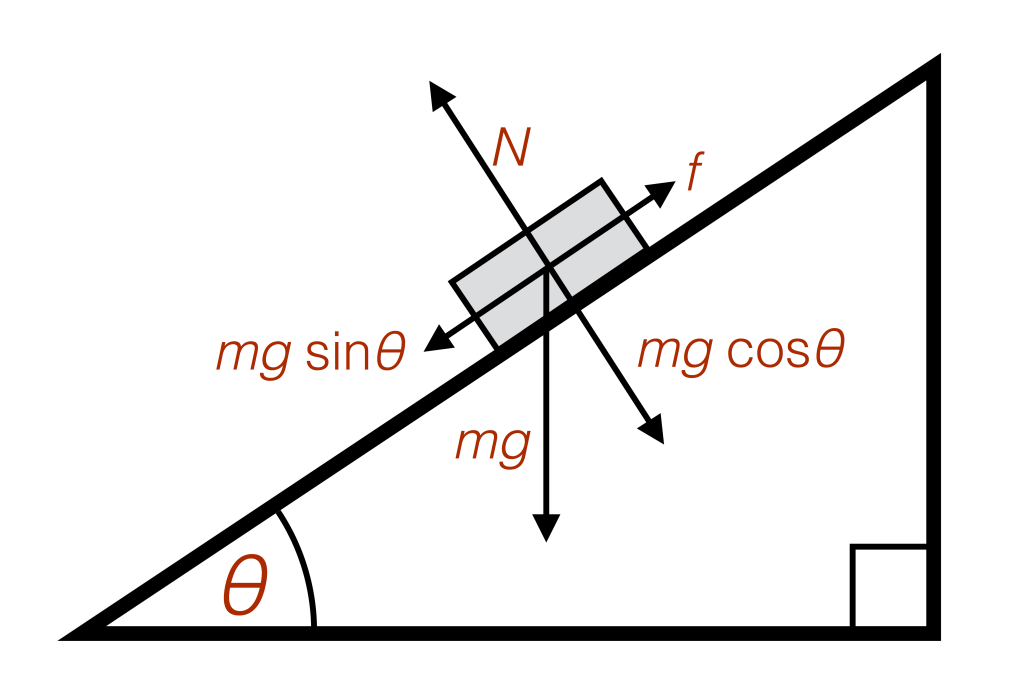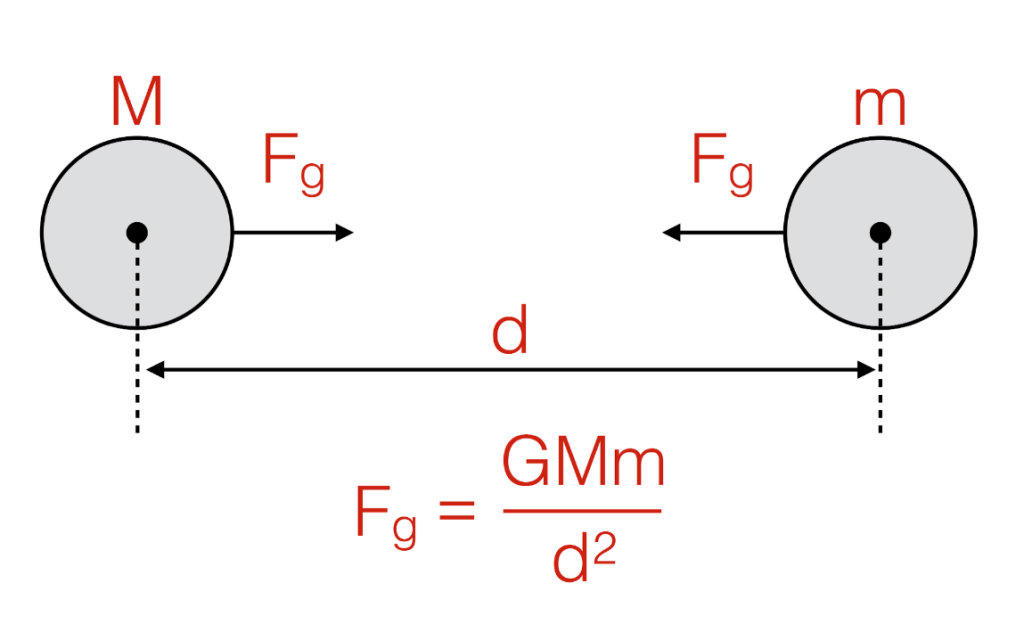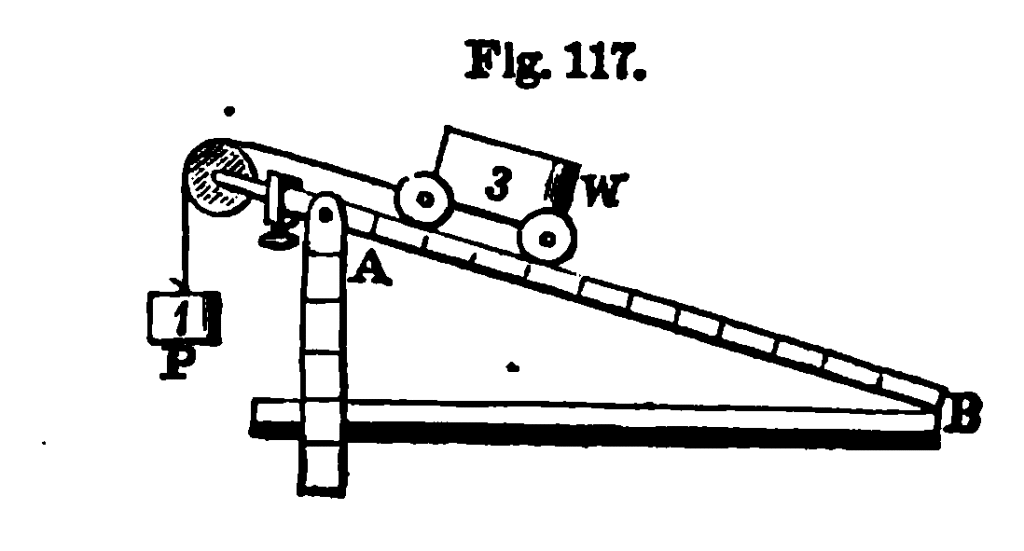The universe began with the Big Bang. But the universe of a physicist begins with a block and an inclined plane. The force of gravity pulls down, the force of the plane pushes to the side. How fast does the block move?
This was one of the reasons I didn’t want to become a physicist. I knew that there would be two years worth of classes about that damn block. Blocks on planes, blocks on pulleys, blocks on levers. Sometimes the block was a ball and it rolled instead of slid. I wanted to study galaxies and protons. I wanted to understand the structure of the universe and the fundamental nature of reality, not some fucking block.
But I took the class anyway. To answer the question of how fast the block moves I learned formulas. Mathematics. The force of gravity is the mass of the block times 9.8 meters per second squared. The force from the plane is that times the sin of the angle of incline. There’s a force of friction pointing up the block.
Put it all together, and you have an answer. Figuring out how to put it all together is the challenge.
As time went on there were other things, spinning tops and projectiles and balls bouncing off walls. And each of these comes with new sets of concepts and ideas and equations. Gravity is constant and points down. Objects can’t move through each other, so they exert forces that point away from being pushed together. Energy is conserved — add up all the energy at the beginning of the problem, do the same at the end, those have to be equal. The same with momentum.
I learned that underneath it all is a pattern, and that pattern is called Newton’s laws. An object moves in a straight line unless acted on by a force; the acceleration of an object is the force divided by the object’s mass; for every force, there is an equal and opposite force.
These laws describe reality.
And then I learned that all of that stuff is wrong. The force of gravity on the block is not 9.8 meters per second squared times the mass of the object being pulled down. The force between two objects is actually the mass of one of those objects times the mass of the other of those objects times a constant divided by the square of the distance between them.
It just happens that if one of those objects is often the Earth, and the other is near the surface of the Earth. Put in the mass of the Earth and the radius of the surface, and 9.8 comes out. It also happens that problems using a constant force of gravity are much easier to solve than ones using the full formula, so people teach students those problems first. They teach them something that is a bit of a lie before getting to the full truth, because it’s easier to process.
And then I learned that the block itself is a lie. The solid, extended object, a homogeneous chunk of matter, doesn’t exist. Instead it’s a lattice of atoms, of nuclei and electrons.
And then I learned that the solidness, the force of the plane on the block and the block on the plane, is not something that fills the space, but a quantum mechanical repulsion between electrons in mostly empty space.
And then I learned that the electrons and nuclei in the block are not objects, but waves of probability.
And then I learned that Special Relativity makes time and space melt into each other. And then that General Relativity shows that there is no force of gravity at all, just the warping of spacetime.
And it’s disorienting and exhilarating and confusing. As each layer falls away I felt inducted into a deeper part of reality, able to look at a block on a slanted table and see new things, but as each layer falls away you’re left wondering what’s next? What’s left? Is anything stable?
Part of the confusion is the dizzying array of mathematics. I learned about equations no popular writer has tried to describe. Hamiltonians and Lagrangians. Renormalization Group Flows. Non-commutative algebras and path integrals and the Variational Calculus. Each one provides a window into the physics of the block, the ball, and top. Each is a window into the nature of reality and each different and wonderful. And each window is, probably, in some way, wrong.
But eventually I realized that there is one thing that’s the same, one thing they all describe, that isn’t a lie. One principle that comes up again and again. The conservation of energy. Add up all the energy at the start of a physical process, it’s the same at the end.
After a year of playing with abstract equations I began to feel that there is something out there, actual stuff in the universe. Many things might happen that we can’t predict and know very little about — planets go off in bizarre, incalculable orbits, molecules combine and re-combine, a turbine in the Grand Coolie Dam spins and the light in your house turns on, a star explodes in a supernova, for a few moments shining brighter than an entire galaxy — but through all that, if you account for everything, the energy is conserved.
In 1998, when I was a sophomore in college, two teams studying supernovas announced a shocking result. They had measured the rate of expansion of the universe far better than previous attempts. And they were going to use those measurements to solve an old problem.
As the universe expands from the Big Bang, the gravity of all matter acting on all other matter slows down that expansion. The question is whether there’s enough matter for that to stop — whether the gravitational pull from all that matter is strong enough to drag the expansion all the way to a stop, and even reverse the direction. This new data was supposed to help answer that question. Instead, what it did was show that that question was wrong.
The universe isn’t slowing down at all, the data said, it’s accelerating. For that to be true, there has to be a new type of energy out there, one that pushes, rather than pulls. That would happen if there’s a constant density of energy everywhere in the universe. This is exciting, because it means that a strange form of matter, called dark energy, really is there.
But that confused me. If there’s a constant density of energy, then as the universe expands there’s more of it. If this is true, energy isn’t conserved. It was clear that I hadn’t understood something. So I went to my professor and asked him what I’d missed. He said, nothing, I had it right. So, I asked, this new form of matter also violates conservation of energy, isn’t that the thing everyone should be amazed by? He paused for a moment and looked confused. Then he suddenly understood what I was missing.
“Oh, no,” he said. “Energy isn’t actually conserved, that was never true in an expanding universe.”
Energy is not conserved in an expanding universe. This absolutely fundamental principle, the one I had been so, so sure about, was actually an approximation of an even deeper one.
It would be years before I had enough math to really understand exactly why, or how we know this, but it’s called Noether’s Theorem, after Emmy Noether, a mathematician working at the turn of the last century. Noether’s theorem that energy is conserved only if the universe itself doesn’t really change in time. But it does. It’s expanding, and cooling. It had a beginning and maybe will have an end. In that universe, the theorem makes clear, the total energy can change. It has many, many other implications as well. It tells us about the conservation of momentum and all the conservation laws; combined with quantum mechanics, you can use it to deduce the existence of electromagnetism and photons. It is the most powerful and fundamental tool a physicist has for understanding the nature of reality.
I have what I wanted, I had learned about the structure of the universe, and it’s a cascade of ideas, each useful in it’s domain, each wrong in many ways as we poke further into reality. Is Noether’s Theorem the end, the deepest principle? I don’t know. No one does.
What I do know is that to go anywhere you have to start by watching a block that doesn’t exist slide down an inclined plane.






